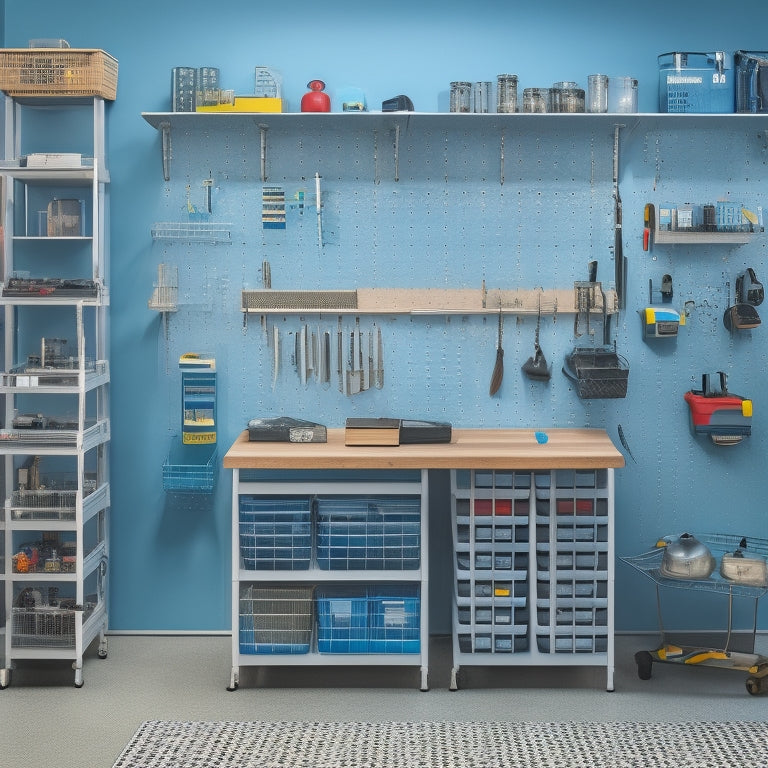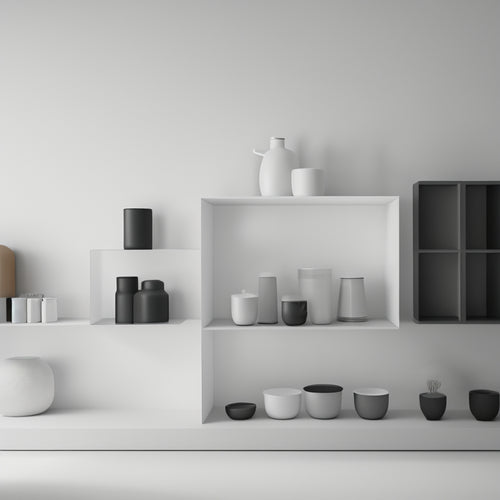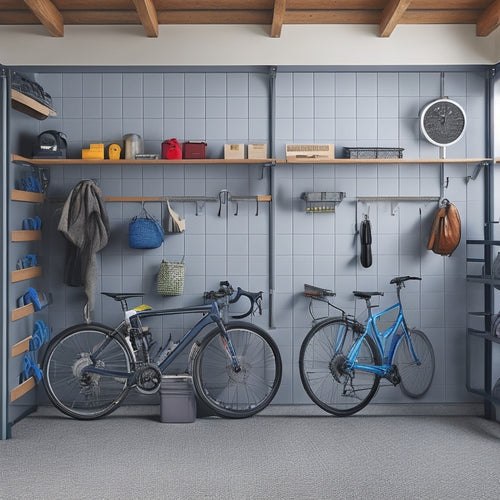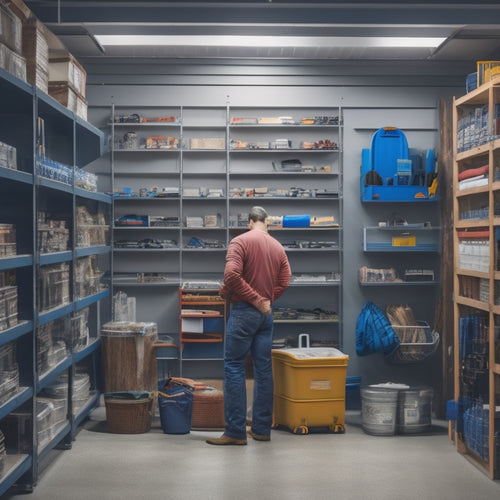
10 Essential Tool Storage and Retrieval System Designs
Share
You need a tool storage and retrieval system that optimizes your workspace, streamlines your workflow, and boosts productivity. Consider modular tool cabinet designs for customization and efficiency. Maximize your wall space with vertical pegboard storage systems or overhead tool storage racks. Adjustable shelving units and compact workbench solutions cater to small spaces. Rotating tool carousels optimize accessibility, while mobile tool cart designs provide portable storage and transportation. Stackable tool chests and sliding drawer organizers enhance storage capacity. Wall-mounted tool holders utilize vertical space. Explore these essential designs to find the perfect fit for your needs, and discover how to take your tool organization to the next level.
Key Takeaways
• Customize tool storage with modular designs to enhance flexibility and reduce clutter.
• Maximize wall space with vertical storage solutions to free up floor space and promote organization.
• Prioritize adjustable shelving and compartmentalization to create dedicated spaces for specific tools.
• Utilize portable tool organization systems with durable handles and wheels for efficient storage and retrieval.
• Designate separate areas for different tool categories to optimize accessible storage and maintain organization.
Modular Tool Cabinet Designs
When designing a tool storage and retrieval system, consider integrating modular tool cabinet designs that allow you to customize your storage space by mixing and matching different cabinet sizes and configurations to fit your specific needs.
This approach enables you to optimize tool cabinet efficiency by allocating space precisely where it's required.
Modular storage benefits include the flexibility to adapt to changing tool inventories, reduce clutter, and improve workflow.
Vertical Pegboard Storage Systems
You can maximize your workshop's wall space by installing a vertical pegboard storage system, which provides a dense, organized, and easily accessible tool storage solution. By utilizing vertical space, you can free up floor space for other tasks or equipment, making your workshop more efficient. A well-organized pegboard also promotes pegboard organization, allowing you to quickly locate and retrieve the tools you need.
Here's a breakdown of the benefits of vertical pegboard storage systems:
| Benefits | Description | Advantages |
|---|---|---|
| Space Saving | Maximizes wall space | Reduces clutter, frees up floor space |
| Accessibility | Tools are easily accessible | Saves time, increases productivity |
| Organization | Tools are organized and visible | Reduces tool loss, improves workflow |
Adjustable Shelving Units
When designing an adjustable shelving unit, three key points need to be considered.
First, prioritize shelving height flexibility to accommodate tools of varying sizes. By doing so, you can customize your storage space to meet your specific needs.
Shelving Height Flexibility
Adjustable shelving units offer the versatility to customize storage configurations by allowing shelves to be easily repositioned to accommodate tools and equipment of varying heights. This flexibility enables you to create a storage system that adapts to your specific needs, maximizing storage capacity and reducing wasted space.
By adjusting the shelf heights, you can store items of different sizes, from small hand tools to larger equipment, in a way that makes sense for your workflow.
When designing your storage system, consider incorporating ergonomic design principles to guarantee that frequently used items are stored at comfortable heights, reducing strain and improving accessibility. Adjustable shelving units also enable you to reconfigure your storage layout as your needs change, making it an ideal solution for dynamic work environments.
Customizable Compartmentalization Options
By incorporating customizable compartmentalization options into your adjustable shelving units, you can further optimize your tool storage and retrieval system by creating dedicated spaces for specific tools or equipment. This allows you to maximize storage capacity, reduce clutter, and increase efficiency.
Customizable dividers enable you to segment your shelves into distinct compartments, making it easy to categorize and store tools by type, size, or frequency of use. You can also implement color coding to visually distinguish between different tool categories or projects, streamlining your workflow.
To take it a step further, you can add tool identification labels to each compartment, providing a clear and concise way to identify the contents without having to physically check. This is especially useful when working with similar-looking tools or equipment.
Additionally, drawer labels can be used to identify the contents of each drawer, making it easy to locate specific tools or equipment. By incorporating these customizable compartmentalization options, you can create a highly organized and efficient tool storage and retrieval system that meets your specific needs and workflow requirements.
Durable Construction Materials
You require adjustable shelving units built with durable construction materials that can withstand the rigors of frequent use and heavy tool storage. This is essential because you need a system that can support the weight of your tools and equipment without compromising its structural integrity.
Look for shelving units made from rust-resistant materials that offer long-lasting strength and durability. This will guarantee that your investment remains functional and reliable over time.
When selecting adjustable shelving units, prioritize weatherproof reliability to protect your tools from environmental elements. Corrosion-resistant materials, such as stainless steel or powder-coated finishes, are ideal for high-humidity or outdoor storage applications. These materials will prevent rust and corrosion, maintaining the shelving unit's structural integrity and securing your tools remain safe and accessible.
Stackable Tool Chests
Stackable tool chests offer a space-saving solution for organizing and storing tools, allowing users to maximize their workshop or garage space. You can optimize your tool chest organization by selecting a stackable design that suits your specific needs.
These chests come in various sizes and configurations, making it easy to customize your storage setup. By stacking your tool chests, you'll be able to store more tools in a smaller footprint, freeing up valuable space for other projects or equipment.
When choosing a stackable tool chest, consider the portability options. Look for chests with durable handles and wheels, making it easy to move them around your workshop or transport them to job sites. Additionally, make sure the chests are designed with secure latching systems to prevent accidental opening during transport.
With a well-designed stackable tool chest, you'll be able to efficiently store and retrieve your tools, increasing your productivity and reducing frustration. By incorporating stackable storage into your tool chest organization, you'll be able to work smarter, not harder.
Sliding Drawer Organizers
Sliding drawer organizers offer smooth access to your tools and equipment, allowing you to swiftly retrieve what you need without having to search through cluttered shelves or compartments.
By including drawer divider options, you can personalize your storage space to suit your specific requirements. This allows you to designate separate areas for frequently used tools, less frequently used items, and even set aside a section for maintenance supplies. This level of organization helps you make the most of your space, reducing mess and boosting productivity.
When choosing a sliding drawer organizer, seek space-efficient solutions that optimize your accessible storage area. Consider features such as adjustable dividers, detachable trays, and ergonomic handles.
To maintain your sliding drawer organizer, apply straightforward organization techniques like sorting tools by type or frequency of use. Regularly clean and inspect your drawers to prevent dust and debris accumulation. By doing so, you'll make certain that your sliding drawer organizer remains an effective and dependable tool storage solution.
With proper upkeep, you'll be able to swiftly locate and retrieve the tools you need, streamlining your workflow and enhancing overall efficiency.
Overhead Tool Storage Racks
When designing an overhead tool storage rack, you'll want to prioritize two key points: maximizing vertical space and incorporating an easy access design.
By doing so, you'll be able to store more tools in a compact area, while also ensuring that the tools you need are quickly within reach.
Maximize Vertical Space
You can reclaim valuable floor space by installing overhead tool storage racks that take advantage of your garage's or workshop's vertical space. This space-saving solution is an innovative storage technique that allows you to maximize your workspace efficiency. By utilizing the often-wasted overhead space, you can free up floor space for more important tasks or tools.
Here are some benefits of overhead tool storage racks:
| Feature | Benefit | Result |
|---|---|---|
| Increased storage capacity | Reduced clutter | Improved organization |
| Easy installation | Quick setup | Minimal disruption |
| Adjustable shelves | Customizable storage | Efficient use of space |
| Durable construction | Long-lasting | Reduced maintenance |
| Versatile design | Suitable for various tools | Increased productivity |
Easy Access Design
By integrating convenient access design elements into your overhead tool storage racks, you can swiftly retrieve and return tools, streamlining your workflow and enhancing productivity. This is particularly crucial in industries where time is critical, such as manufacturing and construction. Convenient access design ensures that tools are organized in a logical and effective manner, making it easy to locate and retrieve the tool you need.
Tool chest organization is vital in achieving easy access. By implementing space-efficient solutions, such as bins and dividers, you can maximize storage capacity while maintaining a clutter-free environment. This, in turn, allows you to quickly identify and access the tool you need.
Additionally, an efficient layout of your tool rack is essential for convenient access. Consider a layout that allows you to access frequently used tools from the front, with less frequently used tools stored towards the back. By integrating these design elements, you can substantially reduce downtime and increase productivity.
Compact Workbench Solutions
Compact workbench solutions are designed to optimize space and efficiency by seamlessly integrating tool storage and retrieval systems into the work surface. As you design your workspace, contemplating compact workbench solutions that prioritize space-saving solutions and portability is key. These solutions are perfect for small workshops, garages, or jobsites where space is limited.
Here are some key features to look for in compact workbench solutions:
-
Folding or collapsible workbenches that can be easily stored away when not in use
-
Modular workstations that can be customized to fit your specific needs
-
Wall-mounted workbenches that maximize vertical space and keep the floor clear
- Portable workbenches with built-in storage that can be easily transported to different jobsites
Rotating Tool Carousels
Rotating tool carousels, designed to optimize accessibility and reduce clutter, offer a 360-degree spinning surface that allows easy retrieval of frequently used tools and supplies. By installing a rotating tool carousel, you can maximize your workspace efficiency and minimize time spent searching for tools.
These carousels are particularly useful in compact workspaces, where every inch counts. With a rotating tool carousel, you can store a large number of tools in a small footprint, making it an ideal space-saving solution.
The rotating design also enhances tool accessibility and organization. You can easily rotate the carousel to access the tools you need, reducing strain and increasing productivity. Additionally, the organized layout of the carousel keeps your tools tidy and prevents clutter from building up.
Wall-Mounted Tool Holders
As you design a wall-mounted tool holder, you'll want to ponder a tool organization system that maximizes storage capacity while keeping frequently used tools within easy reach.
This can be achieved by incorporating adjustable compartments and dividers that allow you to personalize the layout to suit your specific needs.
Tool Organization Systems
Installing wall-mounted tool holders is an effective way to maximize your workshop's vertical space while keeping frequently used tools within easy reach. This allows you to maintain a clutter-free workspace, reducing the time spent searching for tools and increasing productivity.
A well-designed tool organization system also helps prevent damage to tools and reduces the risk of misplacement.
To create an efficient tool organization system, consider the following:
-
Tool belt organization: Utilize tool belts with designated pockets to keep frequently used tools within easy reach, reducing the need to constantly return to a central workstation.
-
Portable tool bags: Store less frequently used tools in portable bags, making them easy to transport to different workstations or job sites.
-
Tool cabinet organization: Organize tools within cabinets using dividers, bins, and labels to ensure effortless identification and retrieval.
- Tool shadowing: Use tool shadowing to visualize the outline of each tool, making it simple to identify when a tool is missing or out of place.
Easy Access Design
What makes wall-mounted tool holders an essential component of an easy access design is their ability to keep frequently used tools at your fingertips, optimizing your workflow and reducing downtime. This design element ensures that you can quickly retrieve the tools you need, without having to dig through a cluttered tool chest or pouch. By keeping your most frequently used tools easily accessible, you can focus on the task at hand, rather than wasting time searching for the right tool.
| Easy Access Design Benefits | Tool Storage Solutions |
|---|---|
| Optimized workflow | Wall-mounted tool holders |
| Reduced downtime | Tool belt organization |
| Increased efficiency | Tool pouch efficiency |
| Improved portability | Tool chest portability |
| Enhanced accessibility | Tool rack accessibility |
Mobile Tool Cart Designs
Your mobile tool cart design should prioritize portability and versatility to guarantee efficient transportation and storage of tools across various workspaces. This allows you to maximize tool cart organization and efficiency by having the right tools at the right place and time.
A well-designed mobile tool cart should also ensure easy tool cart mobility and accessibility, enabling you to move it effortlessly across the workshop or job site.
To achieve this, consider the following key design elements:
-
Adjustable shelving: allows you to customize the storage space to accommodate tools of varying sizes and shapes.
-
Ergonomic handles: provides a comfortable grip, making it easy to push or pull the cart.
-
Lockable casters: enables you to secure the cart in place when not in use, preventing accidental movement or theft.
- Integrated power outlets: provides a convenient charging station for power tools and devices.
Frequently Asked Questions
How Do I Prevent Tool Rust in a Humid Storage Environment?
To prevent tool rust in a humid storage environment, you'll want to use a dehumidifier to maintain a dry atmosphere, and regularly clean and dry your tools as part of your routine tool maintenance.
Can I Customize Storage Systems for Unique Tool Shapes?
You'll be amazed at how easily you can create custom tool holders to fit even the most unusually shaped tools, ensuring a unique tool organization system that maximizes storage space and efficiency.
Are There Storage Systems Suitable for Small, Irregularly-Shaped Tools?
You'll find storage systems that cater to small, irregularly-shaped tools, such as wall-mounted solutions with adjustable compartments or portable organizers with customizable dividers, which efficiently store and protect your unique tools.
How Do I Keep Storage Systems Clean and Dust-Free?
You'll find that a clean storage system starts with dust prevention techniques like sealing containers and using desiccant packets, followed by regular cleaning methods like vacuuming and wiping down surfaces, and finishing with organization tips like categorizing and labeling.
Can I Integrate Storage Systems With Existing Workshop Layouts?
You can seamlessly integrate storage systems with your existing workshop layout to boost workshop efficiency and space optimization. By optimizing tool organization, you'll streamline your workflow, improving overall productivity and reducing downtime.
Related Posts
-

Small Shelving Options for Tight Spaces
You're surrounded by tight spaces in your home, and you need clever shelving solutions that optimize storage without ...
-

Key Features of a Garage Wall Hanging System
You're looking for a garage wall hanging system that's built to last and adapts to your needs. Look for systems made ...
-

Building Garage Shelves in 7 Easy Steps
You're about to convert your garage into a highly functional storage space by building custom shelves in just 7 easy ...


